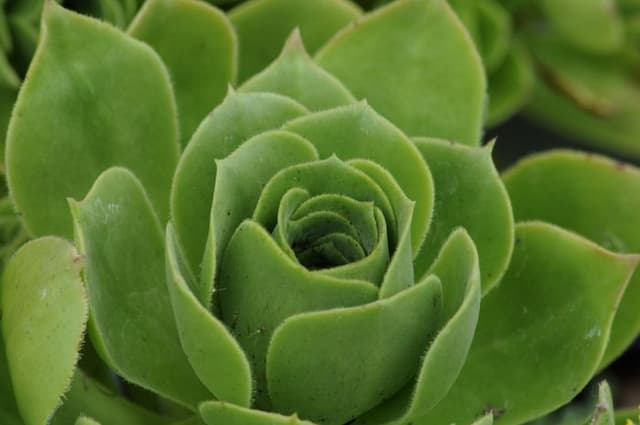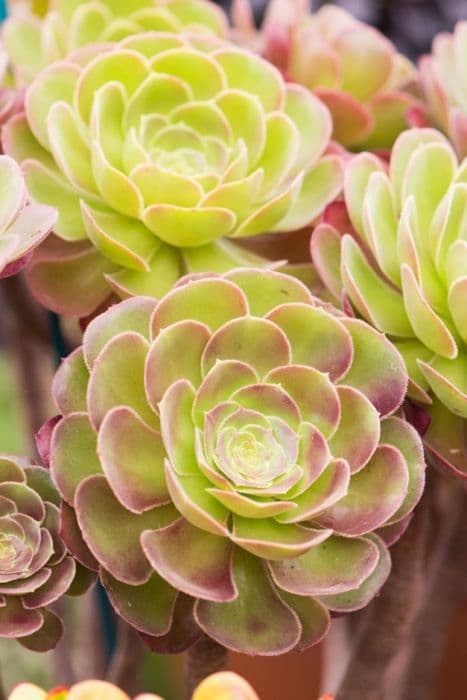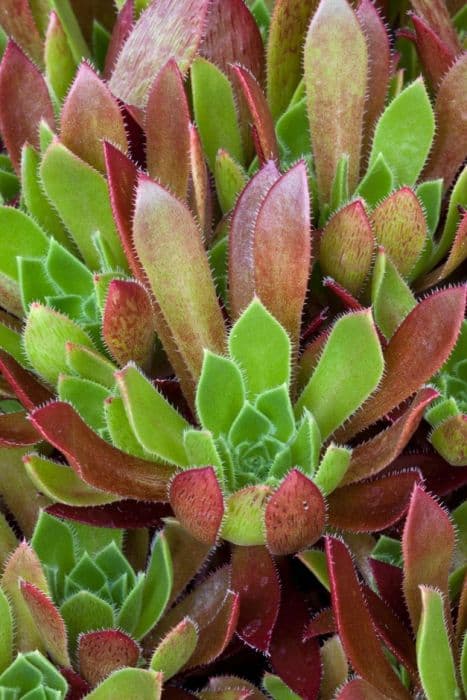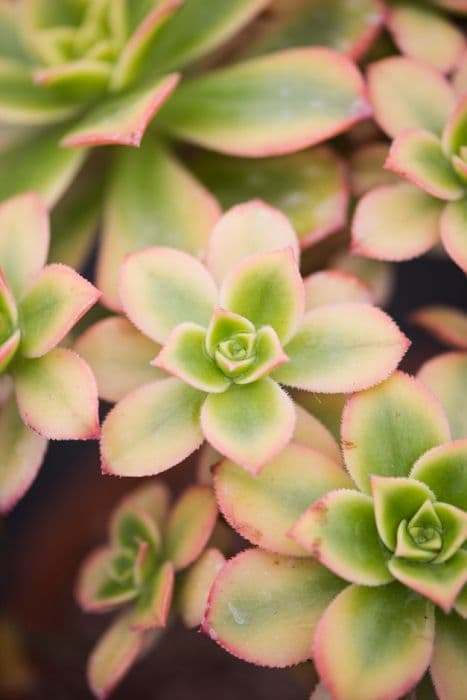Stonecrop Hylotelephium telephium (Atropurpureum Group) 'Xenox' (PBR)

ABOUT
The 'Xenox' is a striking variety known for its ornamental qualities. This beauty flaunts dusty rose-pink flowers, which cluster at the tops of its stems, adding a pop of color to the landscape from late summer to fall. Even before the blossoms emerge, the foliage of this plant is a show-stopper, with succulent-like leaves that sport a deep purple hue, providing a rich, contrasting backdrop for the bright flowers. As the flowering season progresses, the blooms evolve in color, deepening to a rusty red, which extends the visual enjoyment this plant provides well into the fall months. The flowers are attractive to a variety of pollinators, including bees and butterflies, who are drawn to their nectar and pollen. The sturdy stems of the 'Xenox' hold the flower clusters aloft, making them a striking addition to any garden display. As part of a group known for their resilience, this variety can withstand tough conditions and still maintain its appealing look. The plant's dense, fleshy leaves form a bushy, mound-like shape that serves as a beautiful foundational piece in gardens or as an eye-catching feature in floral arrangements once cut.
About this plant
 Names
NamesSynonyms
Stonecrop, Orpine
Common names
Sedum telephium 'Xenox', Sedum telephium (Atropurpureum Group) 'Xenox'.
 Toxicity
ToxicityTo humans
The Stonecrop, as Hylotelephium telephium is commonly known, is not considered highly toxic to humans. Typically, if ingested in small amounts, it does not cause serious harm. However, consuming larger quantities of any part of the plant may potentially lead to mild gastrointestinal upset, as with many plants not meant for consumption. While severe toxicity is rare, it is always advisable to keep plants out of reach of children who might inadvertently ingest them.
To pets
Similar to its effect on humans, the Stonecrop is not highly toxic to pets. If a pet consumes a small part of the plant, they may experience mild gastrointestinal discomfort, including symptoms like vomiting or diarrhea. If a pet ingests a larger amount of Stonecrop, they might exhibit more pronounced gastrointestinal distress. It is always a good practice to monitor pets around plants and discourage them from chewing on plants that are not known to be safe for consumption.
 Characteristics
CharacteristicsLife cycle
Perennials
Foliage type
Deciduous
Color of leaves
Purple
Flower color
Pink
Height
1 feet 4 inches (40 cm)
Spread
1 feet 8 inches (50 cm)
Plant type
Herb
Hardiness zones
4
Native area
Europe
Benefits
 General Benefits
General Benefits- Attracts Pollinators: 'Xenox' sedum is known to attract bees, butterflies, and other beneficial insects to the garden, enhancing pollination.
- Drought Tolerant: Once established, it has a high tolerance for drought, making it suitable for water-wise landscapes and dry garden areas.
- Low Maintenance: This plant requires minimal care once established, making it ideal for gardeners of all skill levels.
- Seasonal Interest: It offers visual interest throughout the seasons with its changing foliage colors and late-summer to fall flowers.
- Suitable for Containers: Its compact growing habit makes it an excellent choice for container gardening and use in small spaces.
- Erosion Control: The dense, mat-forming habit of 'Xenox' sedum can help prevent soil erosion on slopes and in garden beds.
- Edible Qualities: Some parts of sedum plants are edible, though 'Xenox' is primarily grown for ornamental purposes.
- Attractive Foliage: 'Xenox' sedum has distinctive purple leaves that add a unique color contrast in garden beds and borders.
- Resistant to Deer and Rabbits: It's generally resistant to browsing by deer and rabbits, making it a good choice for gardens in areas with wildlife.
- Long-Blooming: The plant produces flowers for an extended period, providing prolonged interest in the garden.
 Medical Properties
Medical PropertiesThis plant is not used for medical purposes.
 Air-purifying Qualities
Air-purifying QualitiesThis plant is not specifically known for air purifying qualities.
 Other Uses
Other Uses- Dye Production: The dark purplish foliage of 'Xenox' sedum can be used to create natural dyes for textiles, offering a range of tones depending on the mordant used.
- Educational Tool: This sedum species can be used in botanical studies and educational programs to illustrate plant adaptations such as succulence and drought resistance.
- Garden Art: The striking appearance of 'Xenox' sedum lends itself to use in garden art installations, harmonizing with sculptures and rock formations.
- Craft Projects: The durable, colorful leaves can be incorporated into craft projects like wreaths or dried flower arrangements.
- Photography Subject: Its unique form and color make 'Xenox' sedum a great subject for botanical photography and plant portraiture.
- Culinary Garnish: Though not widely known as edible, the attractive foliage can be used as a non-toxic garnish to add visual appeal to dishes.
- Cultural Symbol: In some cultures, sedums represent tranquility and are used in gardens to promote a calming atmosphere.
- Fairy Gardens: Miniature gardening enthusiasts sometimes use 'Xenox' sedum to create fairy gardens due to its enchanting appearance.
- Landscape Design Teaching: This cultivar is useful for teaching landscape design principles, showcasing how texture, color, and form contribute to garden aesthetics.
- Green Roofing Systems: 'Xenox' sedum can be used in green roofing systems, as it is hardy and requires minimal soil, contributing to urban biodiversity and insulation.
Interesting Facts
 Feng Shui
Feng ShuiThe Stonecrop is not used in Feng Shui practice.
 Zodiac Sign Compitability
Zodiac Sign CompitabilityThe Stonecrop is not used in astrology practice.
 Plant Symbolism
Plant Symbolism- Resilience: Hylotelephium telephium, commonly known as Sedum, is known for its hardy and resilient nature, able to thrive in challenging conditions with minimal care, symbolizing the ability to persevere and withstand hardships.
- Survival: Sedum plants can survive in poor soil and drought conditions, symbolizing endurance and survival against the odds.
- Adaptability: The Sedum's capacity to adapt to varying environments represents flexibility and the ability to prosper in diverse circumstances.
- Peace: With its lush foliage and soothing presence, Sedum can symbolize tranquility and the bringing of peace to a space or person's life.
- Longevity: As a perennial plant, Sedum signifies long life and eternal renewal, continually coming back year after year.
 Water
WaterStonecrop 'Xenox' should be watered thoroughly, allowing the soil to dry out between waterings. Deep, infrequent watering is preferred to mimic natural rainfall, roughly once every two weeks or when the top inch of soil is dry. During the active growing season in spring and summer, it may require approximately one gallon per plant every two to three weeks, depending on the climate and weather conditions. Over winter, when the plant is dormant, reduce watering to once a month or less, ensuring that the soil is not wet or frozen.
 Light
LightStonecrop 'Xenox' thrives best in full sun with at least six hours of direct sunlight daily. The ideal location would be a south-facing spot that receives ample sunlight throughout the day. While it can tolerate some light shade, especially in hotter climates, full sun encourages the best foliage color and flowering performance.
 Temperature
TemperatureStonecrop 'Xenox' can endure a wide temperature range but performs best between 65°F and 75°F. It is a hardy plant that can withstand temperatures as low as -30°F and as high as 90°F without significant damage. However, providing protection from extreme cold and frost can help in maintaining its health and appearance.
 Pruning
PruningStonecrop 'Xenox' benefits from pruning to maintain shape and encourage denser growth. Deadhead spent blooms after flowering to promote a second bloom and prune back in late fall or early winter after frost has caused the foliage to die back. Cut the plant back to about two to three inches above the soil line. Pruning is typically done once a year, during the plant's dormant period.
 Cleaning
CleaningAs needed
 Soil
SoilSedum 'Xenox' thrives in well-draining soil with a mixture of loam, coarse sand, and peat for moisture retention. The ideal pH for this plant is slightly acidic to neutral, in the range of 6.0 to 7.5.
 Repotting
RepottingSedum 'Xenox' typically requires repotting every 2-3 years to refresh the soil and accommodate root growth.
 Humidity & Misting
Humidity & MistingSedum 'Xenox' prefers a relatively low humidity environment, typical of the average room, without the need for additional humidity.
 Suitable locations
Suitable locationsIndoor
Place in bright light, minimal water.
Outdoor
Full sun, well-drained soil, minimal watering.
Hardiness zone
4-9 USDA
 Life cycle
Life cycleThe life cycle of Hylotelephium telephium 'Xenox', commonly known as Sedum 'Xenox', begins with seed germination, where the seed requires well-draining soil and warmth to sprout. After germination, the seedling emerges and develops into a young plant with characteristic fleshy leaves and a strong stem. As the plant matures, it enters the vegetative stage, producing more leaves and stems, forming a clump of foliage with a distinctive purple hue. Once mature, the plant blooms in late summer to fall, displaying clusters of star-shaped, pink to burgundy flowers that attract pollinators. After flowering, seeds form and are dispersed to begin a new cycle, while the plant itself may enter a period of dormancy during cold winter months. Finally, Sedum 'Xenox' can be propagated asexually through cuttings or division in spring, which can be used to produce new plants and expand growth.
 Propogation
PropogationPropogation time
Late Spring-Early Summer
The most popular method of propagating Hylotelephium telephium 'Xenox', commonly known as Stonecrop, is by stem cuttings. This can be done in late spring or early summer when the plant's stems are mature yet still pliable. Cut a 3 to 4-inch (approximately 7.5 to 10 cm) length from the stem tip, making sure there are a few leaves attached. Allow the cutting to callus over for a day or two to prevent rotting, then insert it into moist, well-draining soil. Keep the soil consistently moist but not waterlogged and place the pot in indirect light. Roots typically develop within a few weeks, after which the new plant can be treated as an established specimen.









